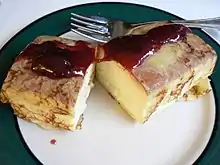Japanese cheesecake
Japanese cheesecake (also soufflé style cheesecake, cotton cheesecake[1] or light cheesecake; Japanese: スフレチーズケーキ[2]) is a variety of cheesecake that is usually lighter in texture and less sweet than North American style cheesecakes. It has a characteristically wobbly, airy texture similar to a soufflé when fresh out of the oven and a chiffon cake like texture when chilled.

The recipe was created by Japanese chef Tomotaro Kuzuno who was inspired by a local käsekuchen cheesecake (a German variant) during a trip to Berlin in the 1960s.[3][4][5] It is less sweet and has fewer calories than standard Western style cheesecakes, containing less cheese and sugar. The cake is made with cream cheese, butter, sugar, and eggs. Similar to chiffon cake or soufflé, this Japanese cheesecake has a fluffy texture produced by whipping egg white and egg yolk separately. It is traditionally made in a bain-marie.[1][6]
The cake was popularised around the world in the 1990s as the signature dish of Uncle Tetsu's Cheesecake bakery that originated in Hakata, Fukuoka, Japan in 1947.[7][8]
See also
References
- Williamson, Olivia (3 September 2015). "3 ingredient cotton cheesecake: why all the hype?" – via www.telegraph.co.uk.
- "Japanese Cheesecake | Just One Cookbook".
- "Japanese Cheesecake | Traditional Cheese Dessert From Japan | TasteAtlas". www.tasteatlas.com. Retrieved 2021-01-30.
- Chowhound. "Light and Fluffy Japanese Cheesecake Is the Dessert of Summer". Chowhound. Retrieved 2021-01-30.
- "A Short History of Japanese Cheesecake | Food & Drink | Metropolis". Metropolis Japan. 2017-05-24. Retrieved 2021-01-30.
- Kamozawa, Aki; Talbot, H. Alexander (23 March 2015). Gluten-Free Flour Power: Bringing Your Favorite Foods Back to the Table. W. W. Norton & Company. ISBN 9780393243437 – via Google Books.
- "Our Story". Uncle Tetsu’s Japanese Cheesecake.
- "China's bakery industry at pivotal point: says national food association".

